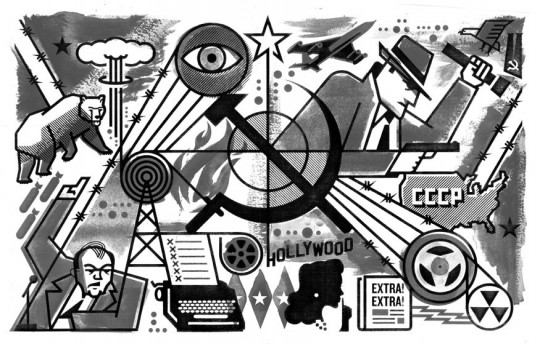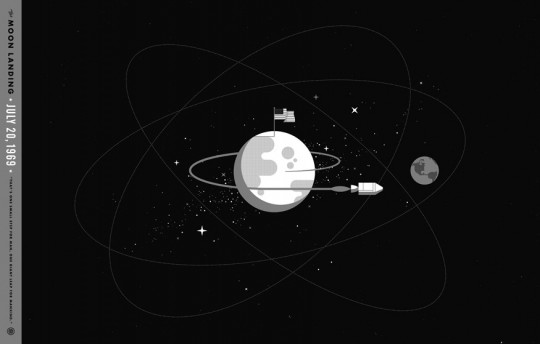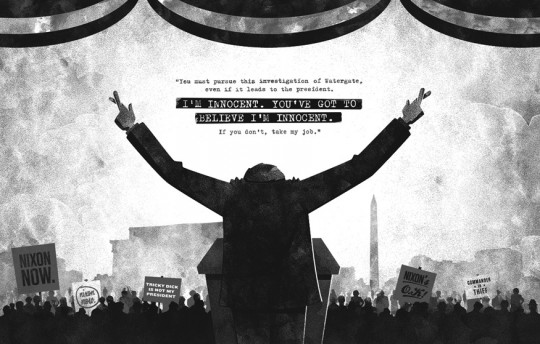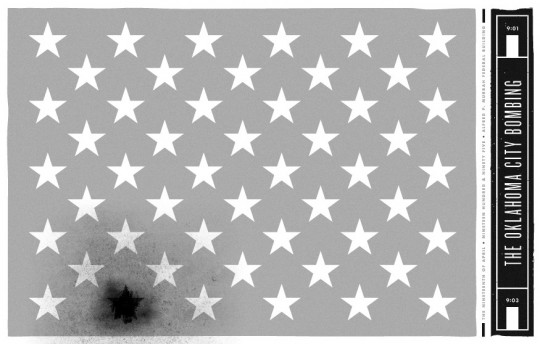Blog
The Momentus project
A presentation of the project
A collaborative project in which a select group of designers, illustrators, and artists create visual interpretations of the most defining moments in United States history as a way of informing others of our proud, yet sometimes troubled and forgotten past.
— From the Momentus Project website
The curator’s interview: words with Evan Stremke
GoMediaZine: Evan, could you introduce yourself to the Zine readers as they might not know you?
Evan Stremke: I’m a designer and writer (and sometimes comedian depending on who you ask), currently living in Madison, and working at Planet Propaganda.
Can you give me some background on the project itself, what sparked it and how it works?
EK: The Momentus Project was born out of an admittedly strange obsession with United States history. Any attempt to trace this fetish back to a specific moment in my life leads me straight to my mom’s life-long infatuation with John Wayne, specifically the film ‘Chisum’. I myself am captivated by another (perhaps more historically significant figure), John F. Kennedy. His assassination sparked my previous self-directed project Invitation to an Assassination. While designing the project myself was an enjoyable challenge, I became interested in seeing how others might handle a similar task. And so the Momentus Project was created.
Did you give any constrains to the roster of designers? There’s a fantastic sense of unity between each submission.
EZ: I set certain limits for submissions with regards to colors and size. I’m a huge fan of black and white photography, and that color palette (or lack thereof), just made sense in a historical context. Obviously the size and orientation were also controlled to make sure they translated easily to a specific size of paper I have in mind in hopes of one day making each piece available as a print.
Any favorites so far?
EZ: This is going to sound like total bullshit, but I honestly love each submission equally. One of the most exciting things about this project has been hearing about the lengths each contributor has gone to research their respective events, and I truly believe that it shows. Each piece is unique, and sheds light on how the contributor interprets the event and its lasting effects. And that’s really what this whole project is about. That, and making awesome shit.
I saw on Dribbble that you were working on the JFK assassination, will it be your own contribution, or is more part of the Invitation to an assassination series?

EK: The piece I posted on Dribbble about the Kennedy assassination is part of my contribution to the Momentus Project. Given my obsession with JFK, it seemed like the most obvious choice for an event.
Did this curation work nurture you as a designer? If yes, how?
EZ: Curating this project has been no easy task. Choosing contributors was fairly straightforward as I tapped a number of friends I’ve made in the community, as well as a few whose work I’ve admired deeply for quite some time. This project served as an opportunity to reach out to those designers and make further connections. Though that’s not to say there weren’t hurdles. The amount of interested contributors honestly shocked me, and I had to turn away a number of individuals who I consider close friends. And then there was the whole sexism thing which was a ton of fun.
What’s coming up next? Like, art wise and for the series itself? A store à la 50 and 50?
EK: I’ve been in talks with the contributors about one day making their pieces available as prints. There are some logistical issues I need to iron out, but I’m crossing my fingers. As I’ve been receiving each submission, I’m realizing that there are certain events in United States history that were left off this list, and it kills me a little inside to know that I didn’t add ‘The Creation of the Transcontinental Railroad’ to the list, as well as a number of others. I’ve been examining a list I generated awhile back, and odds are that I’ll be adding a few more and looking for additional contributors. Beyond the Momentus Project, I’m working on a little something I’m calling ‘Machination’, though I’m keeping a tight lid on that one for now.
A goodbye note?
EK: Simply put I just want to thank everyone for their kind words. I’ve had a great time organizing the project, and I’m incredibly thrilled that people seem to be enjoying the work being produced. Obviously I have nothing to do with each final submission as it appears on the site, so the contributors deserve all of the credit and respect. I know there have been a few issues regarding the integrity of the process, but I’m hoping everyone just sees the project as what it was intended to be, which is simply a collection of amazing designs and illustrations (and a little history lesson as well).
The pieces and the artists
I. The revolutionary war
Considered by many to be the spark that ignited the tinder of American independence, the Revolutionary war was fought between the Kingdom of Great Britain and the thirteen British colonies in North America that opposed the Stamp Act of 1765. Eventually the formation of the Continental Congress provided Americans the capacity with which to organize the Boston Tea Party in 1773. British General Thomas Gage took notice, and two years later sent waves of troops to fight the battles of Lexington and Concord in which the Americans reigned victorious. The Americans finally cut all ties and any chance of reconciliation when, in 1776, they formed a new nation: The United States of America.
A piece by Jon Contino
II. The Declaration of Independence
“We hold these truths to be self-evident, that all men are created equal, that they are endowed by their Creator with certain unalienable Rights, that among these are Life, Liberty, and the Pursuit of Happiness.” This, the second line of the United States Declaration of Independence, is considered one of the most well-known sentences in the English Language, but it took the Continental Congress nearly an entire month to draft and ultimately agree upon their intentions for the new nation before fifty-six delegates finally signed off on the document. A moment that occurred on July 4, 1776, marking the United States’ official separation from Great Britain. A day that we celebrate and know now as our Independence Day.
A piece by Ellis Latham-Brown
III. The Ratification of the Constitution
The Continental Congress, responsible for drafting the United States Constitution, failed to realize they didn’t actually have the authority to impose it. Because of this, the Constitution needed to be ratified. In September of 1787 the Continental Congress debated over the Constitution before submitting it to the original thirteen colonies, nine of which would need to vote in favor of it if it were to pass. A handful of ratifications were approved almost immediately, but Massachusetts required further clarification. This debate eventually gave way to the first ten amendments, or what we know to be our Bill of Rights. The final document was approved by all colonies nearly one year later in July of 1788.
A piece by Erik Hamline
IV. The Louisiana Purchase
As the ink on the United States Constitution was drying, the young nation was experiencing somewhat of a growth spurt. As settlers expanded Westward, it was imperative that the United States maintained control over land that was vital to international trade. This included what is now the state of Louisiana, as well as fourteen other states. The only thing standing in their way was the fact that there were no provisions set forth in the Constitution outlining the acquisition of territory. Also, French emperor Napoleon Bonaparte. Unable to defend the territory during his war with Great Britain, he sold the land for 15 million dollars. In the end, the United States more than doubled in size.
A piece by Emory Allen
V. The Lewis & Clark Expedition
With their eyes set on the Pacific Coast, Meriwether Lewis and William Clark were commissioned by then President Thomas Jefferson to set out on what has become perhaps the most influential American-led expedition in the history of the United States. Their objectives were to study plant and animal life, the geography and topography of the land, and how the region could be exploited for economic purposes. Wanting to open up a trade route with Asia, Lewis and Clark headed toward what is now Fort Clatsop National Memorial in Oregon, all the while accompanied by a fifteen year-old Shoshone Indian, Sacajawea, who served as a translator for the various Native American tribes they would encounter along the way.
A piece by Blake Suarez
VI. The Trail of Tears
In an act that many modern historians have described as genocide, the Trail of Tears was the massive forcible relocation of several Native American nations from their native lands in the southeastern region of the United States. Because of Andrew Jackson’s commitment to these efforts, nearly 50,000 Native Americans were removed from their homes over a period of six years, in which time over 4,000 died from disease and starvation. As slavery became a booming industry in the South, white settlers felt the need to expand their operations. It’s because of this necessity that the newly formed boundaries of these Native American nations were continually subject to rezoning and cession.
A piece by Matt Riley
VII. The Dred Scott Case
Born into slavery in the late 18th century, Dred Scott was eventually purchased by Army Major John Emerson who later died in 1843, leaving Scott in the care of Emerson’s widow Eliza Emerson. In 1846, Scott sued Eliza Emerson for his freedom, but the suit was dismissed because Scott was unable to prove that he was in fact a slave. Scott was granted a new trial which began in 1850, this time against his new owner John Sanford. Again, the court ruled against Scott, and in 1857 the Supreme Court ruled that slaves were not to be considered citizens, had no rights, and were not protected by the Constitution. To this day the Supreme Court has yet to officially overturn the Dred Scott case, but parts have been overruled by the Fourteenth Amendment.
A piece by Jay Schaul
VIII. The Battle of Antietam
The bloodiest single-day battle in American history was fought on September 17, 1862. Taking place on Northern soil during the Civil War, the Battle of Antietam resulted in a total of roughly 23,000 casualties from both the Confederate and Union Armies. After tracking Confederate General Robert E. Lee into Maryland, Union General George B. McClellan launched the first attack at 5:30a, and both sides continued to battle until 5:30p that night. On the morning of September 18, a truce was reached between both sides, and Lee withdrew his troops back to Virginia, a tactical error in that most historians recognize this as the technical definition of losing a battle.
A piece by Glenn Thomas
IX. The Emancipation Proclamation
Less than a week after the Battle of Antietam, the bloodiest day on American soil, President Abraham Lincoln issued The Emancipation Proclamation. Lincoln used his authority as Commander in Chief to suspend civil law in states that had rebelled against the Union, allowing the executive order to proclaim the formal emancipation of all slaves throughout the Confederate States of America that did not voluntarily return to the Union by January of 1863. Once issued by Lincoln, the Emancipation Proclamation was never challenged in court, and upon implementation the proclamation granted immediate freedom to 50,000 slaves, with 3.1 million of the nation’s 4 million slaves soon following.
A piece by Richard Perez
X. The Birth of the National Parks
Triggered by westward expansion, the national parks idea began picking up steam in 1864 when several California state leaders dedicated themselves to protecting the natural wonder known as Yosemite Valley. Shortly after acquiring the valley as a state park, more parks began taking shape across the nation. In Wyoming, Yellowstone became the first national park when it was established by the United States Congress and signed into law by President Ulysses S. Grant in 1872. Since that time, the National Parks Service has grown to maintain over 84.4 million acres across 450 specially designated areas including parks, monuments, memorials, recreational areas, military parks, and more.
A piece by Dan Cassaro
XI. The Wright Brothers Take Flight
Born just four years apart, Wilbur and Orville Wright grew up building bicycles before testing a series of kits and gliders they had designed in the early 20th century to test the limits of human flight. Many of their gliders failed to meet the Wright brothers’ expectations, and each model began performing more and more poorly as the years went on. Faced with a harsh reality, the Wrights constructed their own wind tunnel for researching airfoils as well as measuring lift and drag, and were able to correct earlier miscalculations. And on December 17, 1903, Orville Wright piloted the brothers’ new glider model which flew 120 feet in 12 seconds in what is considered the first sustained flight of a manned aircraft.
A piece by Nate Utesch
XII. The Women’s Suffrage Movement
As early as 1848, women began campaigning for equal rights on the political landscape during the Seneca Falls Convention. When black men were granted the right to vote by the passing of the Fifteenth Amendment, women’s suffrage advocates such as Susan B. Anthony began campaigning on a federal level with the National American Woman Suffrage Association. After a suffrage bill was defeated in the House of Representatives in 1915, Anthony pushed harder to get it passed before the election of 1920. Because of this pressure, President Woodrow Wilson called a special session of Congress, and on August 18, 1920, the Nineteenth Amendment was ratified, making it a law throughout the United States.
A piece by Kristina Collantes
XIII. The Stock Market Crash
In an era when it seemed like the United States could do no wrong, a small number of red flags had popped up, yet had subsequently been ignored by experts as well as the general public, warning of a potential stock market crash. Despite a period of declining real estate values, many speculated that the market could sustain higher price levels for various goods. And on October 24, 1929 (also known as “Black Thursday”), the New York Stock Exchange collapsed as stock prices plummeted and continued to do so for over a month. It remains the most devastating stock market crash in United States history as it acted as the genesis of the Great Depression, with the market finally recovering after World War II.
A piece by Alex Perez
XIV. The Attack on Pearl Harbor
Known as The Hawaii Operation to the Japanese, the attack on Pearl Harbor became the catalyst for World War II, the most widespread war in recorded history. The surprise military attack took place on December 7, 1941 as a preventative attack to keep the United States from interfering with Japanese military exercises in Southeast Asia. Launched in two waves, over 350 Japanese fighters sunk four US Navy battleships, three cruisers, three destroyers, destroyed 188 US aircraft, killing 2,402 men and wounding 1,282 others. Historians speculate that an aborted third Japanese wave could have crushed all hopes of a counter attack by the United States in the Pacific theater. The following day, the United States declared war on Japan.
A piece by John Soat
XV. The Creation of WWII Internment Camps
Shortly after the United States declared war on the Empire of Japan, President Franklin Delano Roosevelt issued Executive Order 9066, resulting in over 110,000 Japanese and Japanese Americans who lived on the western coast of the United States to be excluded from the states of California, Oregon, and Washington, except those moved to “War Relocation Camps”, because of their possible ties to a war enemy. Camps were surrounded by armed guards who had the power to shoot anyone who attempted to leave an exclusion zone. In January of 1945, the order was rescinded, and internees began to leave the camps immediately. In 1988, President Ronald Reagan issued a formal apology on behalf of the United States Government.
A piece by Christopher Haines
XVI. The Bombing of Hiroshima
For more than six months in the latter stages of World War II, the United States and its allies had continuously fire-bombed sixty-seven Japanese cities in an attempt to force a surrender as outlined in the Potsdam Declaration. However, the Empire of Japan stood strong and ignored the ultimatum, leaving President Harry S. Truman with only one device: dropping a nuclear bomb known as “Little Boy” on the city of Hiroshima. Over 166,000 people died as a result of the bombing, with more than half being killed immediately from severe nuclear burns. In the following months, tens of thousands succumbed to radiation poisoning. Nine days after the initial bombing, Japan announced its surrender to the allies, officially ending World War II.
A piece by Chaz Russo
XVII. The Marshall Plan
Named after then Secretary of State George Marshall, the Marshall Plan (officially known as the European Recovery Program), was an aid program which sent monetary support to European economies to help slow the spread of Communism after World War II. Over the course of four years, $13 billion was given to those countries that had joined the Organization for European Economic Co-Operation on top of the $12 billion given to Europe between the end of the war and the beginning of the Marshall Plan. Within four years, the economy of every European country to receive funding had surpassed pre-war levels. The initiative was offered to the Soviet Union as well, but they refused to accept it.
A piece by Matt Braun
XVIII. The McCarthyism Movement
In the post-World War II United States, Wisconsin Republican Senator Joseph McCarthy lead the charge in accusing thousands of Americans of being communists, or communist sympathizers for well over a decade. These Americans became the subjects of highly aggressive, and often times illegal and unwarranted investigations into their loyalty toward the United States. The majority of these citizens were government employees and politicians, as well as those in the entertainment industry. Many were wrongfully imprisoned and had their professional careers tarnished. To this day, the term “McCarthyism” is used to describe any unsubstantiated accusations of disloyalty toward the United States.
A piece by Matt Lehman
XIX. The Bay of Pigs
Within three months of the Kennedy presidency, a CIA-trained force of Cuban exiles was sent to invade and overthrow the Cuban government and their leader Fidel Castro. Prior to the invasion, rumors of the attack circulated not only through Cuba, but throughout the world, and only three days after launching the invasion Cuban armed forces defeated the exile forces and took many of them prisoner. JFK disavowed any US involvement in training the exiles, and refused to take any action that would result in their release until a deal was struck with the Cuban government years later. Many prisoners were so desperate to get word to their families that they released messages in bottles in hopes that they would reach the US shore.
A piece by Scotty Reifsnyder
XX. The Civil Rights Movement

The African-American Civil Rights Movement began to pick up steam in 1955 as it set its sights on restoring voting rights in Southern states, as well as seeking to desegregate much of the nation’s public services. Through the efforts of eminent advocates such as Malcolm X, Rosa Parks, and Martin Luther King, Jr., the Civil Rights Movement became less about political equality, and more about freedom and dignity. In what is perhaps the most famous Civil Rights protest, nearly 300,000 demonstrators marched on Washington to hear Martin Luther King, Jr. deliver his famous “I Have a Dream” speech. Less than a year later, the Civil Rights Act of 1964 was passed, banning discrimination based on “race, color, religion, or national origin.”
A piece by Jon Ashcroft
XXI. The Assassination of JFK

On November 22, 1963, while traveling in a motorcade through the streets of downtown Dallas, Texas, President John F. Kennedy was shot and fatally wounded by an assassin later believed to be Lee Harvey Oswald. The assassination lead to a ten-month investigation by the Warren Commission which concluded that Oswald acted alone in the killing, a fact contested by a vast majority of Americans since 1966. A funeral was held three days later on John F. Kennedy, Jr.’s third birthday, in which representatives from over 90 countries attended, including the Soviet Union with whom the United States was at odds with during the Cold War. Kennedy’s death has been the subject of much controversy and debate ever since.
A piece by Evan Stremke
XXII. The Vietnam War
The Vietnam War saw heightened involvement from the United States in the mid 1960s as the US government viewed participation in the conflict as a way to prevent the spread of communism throughout the world, specifically to South Vietnam regarded at the time as a US puppet state. United States troop levels tripled twice over in as many years with total troop numbers reaching over half a million throughout the duration of the war. US forces were finally withdrawn in 1968 after the Tet Offensive, a successful, yet ultimately disappointing attack which stunned the United States Military. The war officially ended with the North Vietnamese army captured Saigon, and both North and South Vietnam were reunified one year later.
A piece by Tim Boelaars
XXIII. The Moon Landing
In a 1961 address to the United States Congress, then President John F. Kennedy expressed his desire for landing men on the moon saying “I believe that this nation should commit itself to achieving the goal, before this decade is out, of landing a man on the Moon and returning him safely to the Earth.” And though the President didn’t live to see his dream realized, NASA’s Apollo program, with Neil Armstrong, Michael Collins, and Buzz Aldrin crewing the Apollo 11 lunar mission, fulfilled Kennedy’s wish by being the first humans to set foot on the surface of the moon on July 21, 1969. Since then only five Apollo missions have landed men on the Moon, the last being in 1972.
A piece by Mark Weaver
XXIV. The Watergate Scandal
On June 17, 1972, five men broke into, and stole money from the Democratic National Committee headquarters at the Watergate complex in Washington, D.C. A federal investigation by the FBI connected the burglars to a slush fund for the 1972 Committee to Re-elect the President. Through a series of interviews with Nixon staffers and members of his administration conducted by the Senate Watergate Committee, it was discovered that a tape recording system in Nixon’s office captured audio of his attempts to cover up the scandal. Though he fought to keep the tapes a secret, the US Supreme Court ruled that he must hand them over. Facing impeachment, Nixon became the first and only president to voluntarily resign.
A piece by Shed Labs
XXV. The Invention of the Internet
Beginning with point-to-point communication between mainframes, the Internet dates back as far as the 1950s with the development of computers. Several decades later in 1982, the Internet Protocol Suite was launched, introducing a world-wide network of fully interconnected networks. In the early 1990s, commercial service providers allowed public access to the Internet as restrictions on the use of network traffic were lifted. Since that time, the Internet has had a radical effect on global cultural, economical, and political landscapes alike. It’s estimated that in 1993, the Internet transmitted only 1% of all telecommunications information, a figure which had grown to more than 97% by 2007.
A piece by Bobby McKenna
XXVI. The Oklahoma City Bombing
Just over an hour after an explosion at the Alfred P. Murrah Federal Building claimed the lives 168 American citizens, Timothy McVeigh was stopped by an Oklahoma State Trooper for driving without a license plate, and unlawful possession of a weapon. What quickly became the largest criminal investigation in US history eventually concluded that McVeigh and his accomplice Terry Nichols did in fact carry out an American attack on American soil when they were tried and convicted in 1997. McVeigh admitted to timing the explosion to go off on the second anniversary of what he believed to be the US government’s “mishandling” of the Waco Siege. Six years after the bombing, McVeigh was executed by lethal injection.
A piece by Scott Hill
That’s all (so far) folks!
Thanks for taking the time to read more this great project. Feel free to add your observation about the pieces in the comments. Also, any moments you would have added? Removed? Interpreted differently?
Link recap
- The Momentus Project – momentusproject.com
- Evan’s website – hello.evanstremke.com
The artists and their piece
- The Revolutionary War – Jon Contino
- The Declaration of Independence – Ellis Latham-Brown
- The Ratification of the Constitution – Erik Hamline
- The Louisiana Purchase – Emory Allen
- The Lewis & Clark Expedition – Blake Suarez
- The Trail of Tears – Matt Riley
- The Dred Scott Case – Jay Schaul
- The Battle of Antietam – Glenn Thomas
- The Emancipation Proclamation – Richard Perez
- The Birth of National Parks – Dan Cassaro
- The Wright Brothers Take Flight – Nate Utesch
- The Women’s Suffrage Movement – Kristina Collantes
- The Stock Market Crash – Alex Perez
- The Attack on Pearl Harbor – John Soat
- The Creation of WWII Internment Camps – Chris Haines
- The Bombing of Hiroshima – Chaz Russo
- The Marshall Plan – Matt Braun
- The McCarthyism Movement – Matt Lehman
- The Bay of Pigs – Scotty Reifsnyder
- The Civil Rights Movement – Jon Ashcroft
- The Assassination of JFK – Evan Stremke
- The Vietnam War – Tim Boelaars
- The Moon Landing – Mark Weaver
- The Watergate Scandal – Shed Labs
The ones still to be unveiled
- The Invention of the Internet – Bobby McKenna
- The Oklahoma City Bombing – Scott Hill
- The 2000 Presidential Election – Tad Carpenter
- The Attacks of September 11, 2001 – Ted Quinn
- The Invasion of Iraq – Two Arms
- The Hurricane Katrina Disaster – Kendrick Kidd
- The Election of Barack Obama – Tymn Armstrong

























